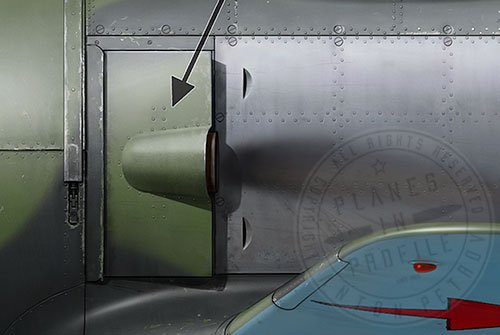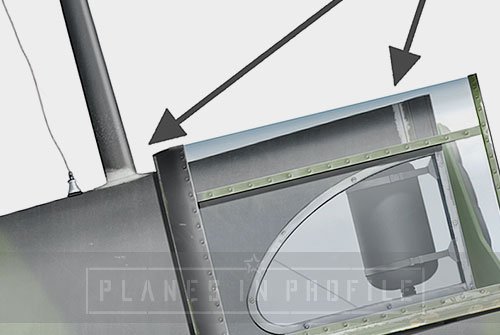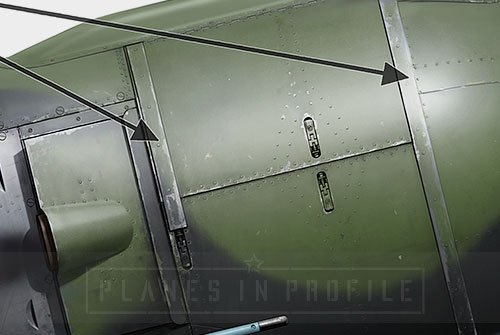Serov’s White-66 “Eskadril’ya Valeriy Chkalov”
LAVOCHKIN, LA-5 (TYPE 37)
159th IAP, 275th IAD, 13th Air Army, Leningrad Front, Summer 1943.
Flown by the deputy squadron commander, (future)Hero of the Soviet Union, lieutenant Vladimir Georgievich Serov (an Ace with (future) 45 victories (39 personal and 6 shared))
‘Tall and very strong, a good guitarist and singer, Serov often delighted his comrades with a performance. When they’d say to him “You should be in the theatre,” he’d reply "My theatre is the sky, ” ‘[1] And indeed, it was in the sky that Serov gave his greatest performances. In the summer of 1943, White-66 was the instrument with which Serov “ performed deadly songs” for the Luftwaffe.
159th regiment trained to operate La-5 planes from the 15th of December 1942 in the 2nd ZIAP in Seyma, and on the 18th of March 1943 the regiment commenced battle work again, this time equipped with their La-5s [2]. Serov most likely flew battle sorties in the White-66 from that date and in the summer of 1943, during which time he scored 11 victories. Although, I was unable to confirm if Serov flew the 'White-66' exclusively during that time and if all of these victories were scored in 'White-66'.
The first of these victories was on the 2nd of May 1943 when Serov downed a Focke Wulf 190. It was Serov’s 5th confirmed victory, thus elevating him to the status of an Ace.
5) 02.05.1943 1 FW-190 Pushkin (Пушкин) Russia
The next day he and his leader Aleksandr Bulaev both scored personal victories, by downing a FW-190 each
6) 03.05.1943 1 FW-190 Strel’na (Стрельна ) Russia
Sadly, Serov’s leader A. Bulaev died in an air catastrophe on the 17th of that month, he was flying as a passenger in a Li-2 cargo plane when it crashed. Serov learned a lot from Bulaev during the time when he was Bulaev’s wingman. He really looked up to Bulaev as a mentor and inevitably picked up not only some of Bulaev’s “stranglehold” fighting style and preference to fire in short bursts from close range, but even a bit of Bulaev’s walk and manner of speaking [3]. After Bulaev (who commanded the squadron) died, Petr Likholetov became the squadron commander and Serov became the deputy.
Serov’s next three confirmed victories, which might have been scored in White-66, were scored on the 19th of June 1943.
7) 19.06.1943 1 He-111 south-east of Volkhovstroy (юго-вост.Волховстрой) Russia
8) 19.06.1943 1/5 He-111 Volhovstroy (Волховстрой) Russia
9) 19.06.1943 1/5 FW-190 Volhovstroy (Волховстрой) Russia
White-66 was serviced by an excellent mechanic whose surname was Klimov, but whom Serov called ‘Klimych’. Klimych ensured that Serov’s La-5 was in top condition for the air battles, but Klimych didn’t feel that he’s doing enough to avenge the enemy. The website ‘airaces.narod.ru’ describes a conversation about this between Serov and Klimych, which occurred sometime after Serov’s 8th victory. A part of this conversation went like this:
- How many planes were shot down by the pilots who fought on the machines that you prepared for battle? Serov asked in his turn.
- With your 8th it will be 26.
- You can safely write half of them to your score. This is fair. Just recently, the four of us fought against eight Focke-Wulfs. We fought in verticals, and my plane, gaining altitude, even trembled from the effort. Well, I think the engine will snort - I'm gone. But it didn't snort. I not only caught up with the Fokker, but even overtook it, and when I found myself on top, I pecked it in the forehead. And then I shouted with joy: "Thank you, Klimych!". I thanked you for the engine.
Even as Serov became one of the best fighter pilots of the Leningrad Front he still referred to his mechanic as his ‘battle comrade’. Whenever Serov returned from a battle sortie with a victory he’d shout out to Klimych from his airplane: “Klymich, I’ve downed one more, consider it for the two of us!” [4]
These were the victories that “The two of them” scored in the second half of June:
10) 21.06.1943 1 FW-190 south-east of Malaya Vloya (юго-вост. Малая Влоя) Russia ?
11) 21.06.1943 1 FW-190 north-west of Volkhovstroy (сев.-зап.Волховстрой) Russia
12) 22.06.1943 1/5 Me-110 north of Dus’evo. (сев. Дусьево) Russia
13) 23.06.1943 1/6 Ju-87 south of Appsala (юж.Аппсала) ??
and two more in July and August
14) 13.07.1943 1 FW-190 south of Lipki (юж. Липки) Russia ?
15) 11.08.1943 1 FW-190 south-east of Arbuzovo (юго-вост.Арбузово) Russia
Serov’s “lethal song for the Luftwaffe” kept blasting loud and clear from the cannons of his La-5 as he went on to score 30 more victories starting from February 1944, but it is likely that in February 1944 Serov was already flying a White-70, La-5F fighter, which he flew in battle during the spring of 1944.
On the 26th of June 1944 Serov perished in air combat. By that time Serov flew about 300 battle sorties and engaged in 104 air battles, his victory score stood at 45 confirmed victories (39 personal, 6 shared). [5]
Noteworthy Visual Characteristics
General) The plane seems to have been painted in a standard Green/Black camo, with the stars in the usual 6 positions, 2 on the lower surfaces of the wings, 2 on the tail and 2 on the fuselage. The plane was marked with the Eskadril’ya Valeriy Chkalov inscription. The plane must have been covered with white MK-7 paint originally judging by some traces of it still visible in some areas.
1) The cowl flap seems to have been painted AMT-4 green, with a bit of black overspray covering the bottom part of it.
2) ‘Эскадрилья Валерий Чкалов’ (Eskadril’ya Valeriy Chkalov)- translates to ‘Squadron Valery Chkalov’. This inscription appeared on the airplanes built with the funds which were raised and donated to the ‘Red Army war fund’ by the workers of the Gorkiy (Today’s Nizhniy Novgorod) region. Many collective farms participated in this ‘fund raiser’ and a total of about 60, 000,000 roubles was raised , a further 1.1 million was raised by the Fire Brigades of the Gorkiy region- astronomical amounts of money for that time. Even schools participated in the collection of funds for the E.V.Ch airplanes, and at least one airplane was known to have been built with these.
These funds were enough to build about 200 airplanes, mostly La-5s and some LaGG-3s, which were distributed across many different units, including the 159 IAP, as well as 11 IAP, 21 IAP, 193 IAP, 4 GIAP KBF, 5 GIAP, 41 GIAP, 111 GIAP, 180 GIAP, 3 IAK.
Valeriy Chkalov was a famous Soviet test pilot who died in 1938 during a test flight of a Polikarpov I-180. He was from the Nizhniy Novgorod (former Gorkiy) region, which is why the airplanes bare his name.
Massimo Tessitori did some good research on the ‘Eskadrilya Valeriy Chkalov’ and it’s worth visiting his website HERE to learn more about the “Eskadrilya”.
3) There appear to be traces of temporary white MK-7 paint visible on some parts of the plane. Especially noticeable as a white line on top of the plane just under the moving part of the canopy, as well as at the base of the antena mast.
4) The cowl bands look like they were painted. Judging by the condition of the plane some of the paint probably was chipped off in places on the cowling bands.
5) ‘От колхозников и колхозниц Горьковской Области’ ( Ot kolkhoznikov i kolkhoznits Gor’kovskoy oblasti) - Translates to ‘From the collective farmers(male) and the collective farmers (female) of the Gorkiy region’.
This is the most common inscription that appeared on the starboard side of most E.V.Ch. airplanes. However, sometimes this inscription was ‘ Gorkovskiy Pozharniy’ as can be seen on Devyatkin’s La-5.
I used photos of ‘White-99’ and ‘White-40’ as my reference for painting the starboard side slogan on ‘White-66’.
8) The warning on the wheel shields might have read ‘Не Вставать’ which loosely translates to ‘Don’t get up (on top of) ’. This seems to have been more common to the early La-5 planes than the other variation of this warning which is ‘Не Становиться’ (loosely translates to ‘Don’t stand on’ ) which was more common to the later La-5 modifications.
The plane as it might have looked in late summer of 1943 and later.
General). The plane was a bit more aged/weathered by this time, but the main point to note is that from the summer of 1943 (exact date is unknown) the planes of 275th IAD were marked with a white (or even silver?) spinner and rudder [6], indicated by '7a' and '7b' in the illustration above. Though there is no guarantee that all the planes of the 275th IAD were marked with these markings, as some photos from that period suggest, there is a very high chance that 'White-66' might have received these markings at some stage.
Here are a few close-up images to help illustrate the points above. Full set of close-up images is On Patreon
Footnotes
[1] Info is based on the passage from the book called “ПАМЯТЬ ЗЕМЛИ” (Memory of the earth) by Krasilnikov, page 98
Красильников, Р.В. Память Земли. Рассказы о поисковой работе / Р.В. Красильников – М.: Спецкнига, 2012. – 180 с. ISBN 978-5-91891-125-9
[2] Info taken from the book ‘Все истребительные авиаполки Сталина’ (Vse Istrebitelnye Aviapolki Stalina) by Vladimir Anohin and Mihail Bykov, published by Yauza-press in 2014, page 419.
[3] This info is taken from the article called “Soviet Ace Vladimir Serov” published in a newspaper“Leningrad’s Truth” ,issue number 167, 06.08.1944
[4] As described on http://airaces.narod.ru/all1/serov_vg.htm
[5] As always, the information about the victories is taken from Mikhail Bykov’s book called ‘Все Асы Сталина’ (All of Stalin’s Aces), page 1083. Youza-press, 2014.
[6] This info is according to page about the markings of the 275th IAD http://wio.ru/simbols/iad275.htm#iap159
Summary of LINKS TO THE REFERENCE IMAGES AND VIDEOS
Image 1
http://soviet-aces-1936-53.ru/abc/s/serov_vg6.jpg
Image 2
http://massimotessitori.altervista.org/sovietwarplanes/pages/la5/chkalov/chkalov66fr.jpg
The work presented on this is page is subject to updates and revisions in the light of new information which might present itself. If you have any new information relevant to this page or disagree with anything that's presented here, then please feel free to contact me through the Planes in Profile Facebook page. Thanks:)





